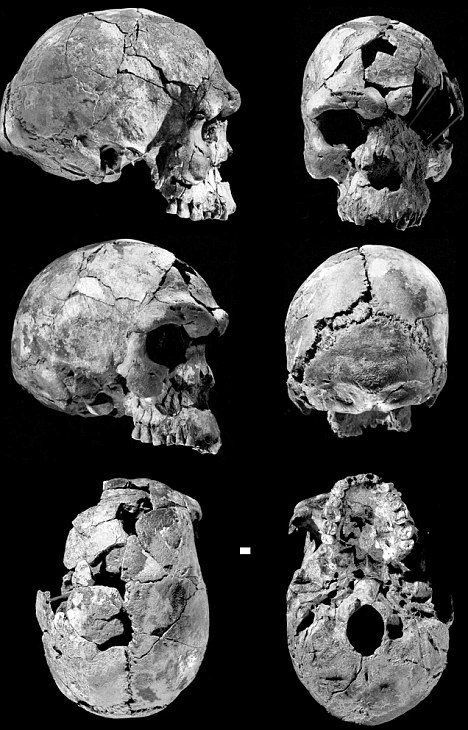Modern humans are about 10 percent smaller and shorter than our hunter-gatherer ancestors, scientists have found, and our brains have fallen in size by the same proportion.
Most of that decline in physical size has occurred since the advent of farming about 10,000 years ago.

Research shows that declines in height occurred in 19 of 21 societies that switched from hunter-gathering to farming - perhaps the greatest change in lifestyle in human history.
The findings pose a puzzle since societies that switch to farming usually experience a population boom as food becomes more plentiful.
Comment: Plentiful food, or plentiful poison? It's a sad and devastating truth that the adoption of agriculture, supposedly our most decisive step toward a better life, was in many ways a catastrophe from which we have never recovered. Not only it didn't make the life easier, agriculture in fact led commonly to a lower quality of life.
From Agriculture: The Worst Mistake In The History Of The Human Race:
While the case for the progressivist view seems overwhelming, it's hard to prove. How do you show that the lives of people 10,000 years ago got better when they abandoned hunting and gathering for farming? Until recently, archaeologists had to resort to indirect tests, whose results (surprisingly) failed to support the progressivist view. Here's one example of an indirect test: Are twentieth century hunter-gatherers really worse off than farmers? Scattered throughout the world, several dozen groups of so- called primitive people, like the Kalahari Bushmen, continue to support themselves that way. It turns out that these people have plenty of leisure time, sleep a good deal, and work less hard than their farming neighbors.
Decline in stature is a phenomenon more commonly linked to food shortages and malnutrition.
Amanda Mummert, an anthropologist at Emory University in Atlanta, Georgia, suggests the drop in heights could be linked to a shortage of micro-nutrients as human diets took in less variety.
Although calories were abundant, the vitamins and minerals essential to growth - and which are only gained through a varied diet - may have become less common in people's diets.
Comment: Diet devoid of essential nutrients is only one of many damaging consequences of farming. According to Jared Diamond, author of Agriculture: The Worst Mistake In The History Of The Human Race, there are at least three sets of reasons to explain the findings that agriculture was bad for health:
- Hunter-gatherers enjoyed a varied diet, while early farmers obtained most of their food from one or a few starchy crops.
- Because of the dependence on a limited number of crops, farmers ran the risk of starvation if one crop failed.
- The mere fact that agriculture encouraged people to clump together in crowded societies, many of which then carried on trade with other crowded societies, led to the spread of parasites and infectious disease.
One example of such a change was in China, where early farmers relied on cereals like buckwheat, maize and rice - all of which lack niacin, a vital nutrient for growth.
'This counter-intuitive increase in nutritional diseases resulted from seasonal hunger, reliance on single crops deficient in essential nutrients, crop blights, social inequalities and trade,' she told the Sunday Times.
Systematic studies of fossilised human remains found across Africa, Europe and Asia seem to back up Miss Mummert's findings.

The earliest human remains yet discovered date back to this time, and were found in Ethiopia.
According to Dr Lahr, these people had cranial features similar to modern humans, but were significantly larger and more robust.
Human fossil evidence over the next 190,000 years is patchy and incomplete, but it shows that humans remained tall and robust even as human culture began to emerge, as shown by the appearance of tools, weapons, needles and even musical instruments.
This size was maintained until about 10,000 years ago - the time of the advent of farming - when many populations began to show reductions in stature - and brain size.
But other researchers are less certain about the role agriculture has played in shrinking human proportions.
Chris Stringer, professor of human origins at the Natural History Museum in London, concedes that early humans were had bigger bodies and brains than modern people.
'Some of this must be down to the demands of a Palaeolithic lifestyle in terms of a strong-muscled skeleton on the one hand, and the shielding effect of cultural innovations and a more sedentary lifestyle on the other, but it is unclear whether that is the whole story,' he told the Times.

But even if agriculture were the reason why modern humans are smaller than our forebears, it would not solve the puzzle of why brains have also shrunk.
Comment: It is not puzzling so much as horrifying to realize that the introduction of agriculture led to a systematic degradation of the human race, with a shrinking of the brain being the unavoidable result. The consumption of poisonous grains actually carries much sinister ramifications than shrinking bodies and a gradually increasing rate of higher mortality.
Greg Wadley and Angus Martin, authors of Origins of Agriculture - Did Civilization Arise to Deliver a Fix? write the following:
Recent discoveries of potentially psychoactive substances in certain agricultural products - cereals and milk - suggest an additional perspective on the adoption of agriculture and the behavioral changes ('civilisation') that followed it. In this paper we review the evidence for the drug-like properties of these foods, and then show how they can help to solve the biological puzzle just described...
Prompted by a possible link between diet and mental illness, several researchers in the late 1970s began investigating the occurrence of drug-like substances in some common foodstuffs.
Research in some Pacific communities showed that schizophrenia became prevalent in these populations only after they became 'partially westernised and consumed wheat, barley beer, and rice' (Dohan 1984).
Groups led by Zioudrou (1979) and Brantl (1979) found opioid activity in wheat, maize and barley (exorphins), and bovine and human milk (casomorphin), as well as stimulatory activity in these proteins, and in oats, rye and soy.
Cereal exorphin is much stronger than bovine casomorphin, which in turn is stronger than human casomorphin. Mycroft et al. (1982, 1987) found an analogue of MIF-1, a naturally occurring dopaminergic peptide, in wheat and milk...
Most common drugs of addiction are either opioid (e.g heroin and morphine) or dopaminergic (e.g. cocaine and amphetamine), and work by activating reward centres in the brain. Hence we may ask, do these findings mean that cereals and milk are chemically rewarding? Are humans somehow 'addicted' to these foods?
The Homo sapiens with the biggest brains lived 20,000 to 30,000 years ago in Europe.
Known as Cro-Magnons, they were tall with barrel chests and large jaws. Their brains had an average volume of 1,500cc.
These days, the male human brain averages 1,350cc, a decrease equivalent in volume to a tennis ball. Female brains have shrunk by about the same proportion.
Dr Lahr thinks that part of the answer may lie in improving efficiency - brain function commands about a quarter of all the energy used by the body.
Comment: Judging by the state of our world today, even if there is an improved efficiency in brain functions, it is being rendered useless by the highly addictive properties of various cultivated cereals. What good is having an 'upgraded' brain when its junky "software" is busy pushing reward buttons like a rat in a maze? The lights are on, but there's nobody home!
And this fact is being abused to the hilt by those who not only don't have our best interests at heart, but who indeed benefit greatly from the institution of agriculture, the worst mistake in human history.
Consider the following from Origins of Agriculture - Did Civilization Arise to Deliver a Fix?:
It is noteworthy that the extent to which early groups became civilised correlates with the type of agriculture they practised. That is, major civilisations (in south-west Asia, Europe, India, and east and parts of South-East Asia; central and parts of north and south America; Egypt, Ethiopia and parts of tropical and west Africa) stemmed from groups which practised cereal, particularly wheat, agriculture (Bender 1975:12, Adams 1987:201, Thatcher 1987:212). (The rarer nomadic civilisations were based on dairy farming.)
Groups which practised vegeculture (of fruits, tubers etc.), or no agriculture (in tropical and south Africa, north and central Asia, Australia, New Guinea and the Pacific, and much of north and south America) did not become civilised to the same extent.
Thus major civilisations have in common that their populations were frequent ingesters of exorphins. We propose that large, hierarchical states were a natural consequence among such populations. Civilisation arose because reliable, on-demand availability of dietary opioids to individuals changed their behaviour, reducing aggression, and allowed them to become tolerant of sedentary life in crowded groups, to perform regular work, and to be more easily subjugated by rulers. Two socioeconomic classes emerged where before there had been only one (Johnson & Earle 1987:270), thus establishing a pattern which has been prevalent since that time.
Like advances in silicon chip technology, huge energy savings can be made by getting the same work out of less equipment.
'We may have smaller brains than early humans but it doesn't mean we are less intelligent,' she said.



called "decay". However, with time it happens to every "system" and in physics it's called "entropy".